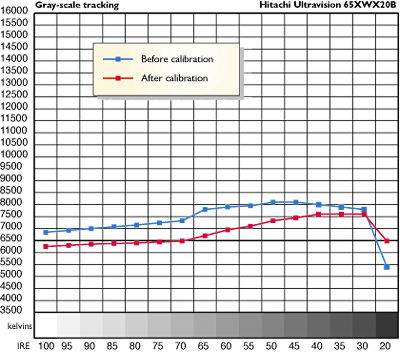Hitachi Ultravision 65XWX20B rear-projection CRT HDTV Calibration

The 65XWX20B's scaler's performance was adequate though not state-of-the-art performance, as described by TJN in the "Calibration" sidebar of his 51SWX20B review in November 2002. His observations about overscan jibed with what I saw, though the 65XWX20B's pre-calibration gray-scale numbers were not as far off as what he measured on the 51SWX20B. The post-calibration gray-scale tracking results were not ideal, as you can see; why they differed from TJN's calibration, I don't know.
When I spoke with Bill Whalen, Hitachi's senior product and marketing manager, he sounded surprised. He told me that his sample of the 65XWX20B tracked very similar to TJN's post-calibration results. I saw a very slight tendency toward green at the dark end of the scale while watching test patterns, but I saw nothing indicating a gray-scale tracking problem on normal program material, including black-and-white movies.
Convergence was extremely stable; I was impressed by how well-converged the test patterns were, even in the extreme corners. I noticed no post-calibration red push, though the overall color balance was improved by turning the Color control down a few notches from its midpoint. I've been told that the 65XWX20B uses a more accurate color decoder than the 51SWX20B. None of the actual setting numbers on the 65XWX20B matched those on TJN's 51SWX20B, though TJN pointed out that sample-to-sample variation would make that likely.
Geometry was outstanding—similar to that of a good direct-view set—and on the PLUGE pattern, I noted less crescent-shaped reflection than any RPTV I've seen. The uniformity of color and light output were also outstanding, and video noise was extremely low. The measured performance of the post-calibration Ultravision 65XWX20B was, in most respects, exemplary.—MF
- Log in or register to post comments




































































